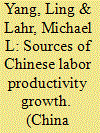| Srl | Item |
| 1 |
ID:
128417


|
|
|
|
|
| Publication |
2014.
|
| Summary/Abstract |
Increasing use of energy has helped to stimulate China's economy. Despite central planning, China has great differences in economic development, energy endowment and energy consumption across its regions. This paper uses the structural decomposition approach to uncover the regional disparities in energy consumption from 1987 to 2007. We also examine six possible key factors for the change in energy consumption by region. We find that final demand change outpaced efficiency improvements to drive up energy use in all regions between 1987 and 2007. More surprisingly, from 2002 to 2007, it appears that changes in production structure enhanced energy consumption in most regions. China produced more energy-intensive goods for capital investment and export. We contend that improving the energy efficiency of key energy-intensive sectors would lead a significant decline in energy intensity. Energy, directly or indirectly, is flowing from Northwest, Central and North China to coastal regions. Regional-specific policies should be designed to promote production structure change and curb energy demand.
|
|
|
|
|
|
|
|
|
|
|
|
|
|
|
|
| 2 |
ID:
101157


|
|
|
|
|
| Publication |
2010.
|
| Summary/Abstract |
We decompose labor productivity growth from 1987 to 2005 by examining six partial factors (both supply and demand): changes in value-added coefficients, labor inputs, shares of sectoral demands that are fulfilled domestically, input mix, and the intra-sectoral shares and intersectoral mix of final demand. Our analysis confirms that simply by virtue of its size and extremely low level of labor productivity, China's farm sector continues to weigh heavily in China's overall economic advances. Labor savings have levied the largest influence on the labor productivity on all sectors across all three study subperiods. We find that this transition is highly correlated with capital deepening that accompanies China's opening up process. Still, changes in the intra-sectoral shares and the intersectoral mix of China's final demand also have become quite strong, especially in recent periods. Due to ever-increasing competitive pressures as China continues to open, changes in industries value-added coefficients have tended to counteract some of the positive benefits of labor savings for most sectors. The effects on changes in labor productivity of technology change and changes in the use of imports have been comparatively negligible and any variation in their sectoral effects have been waning over time.
|
|
|
|
|
|
|
|
|
|
|
|
|
|
|
|